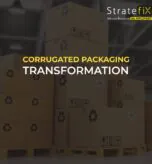A Stratefix Consulting Guide for Indian SMEs, Manufacturers, and Business Leaders
In today’s economy, every rupee matters. Business owners and CFOs across India are under constant pressure to improve profitability, reduce costs, and increase operational efficiency. But here’s the problem: many businesses confuse cost-cutting with cost optimization. The result? Short-term savings that lead to long-term losses.
At Stratefix Consulting, we’ve worked with 550+ SMEs across 75+ industries and seen firsthand how knee-jerk cost-cutting laying off people, slashing marketing, or buying in bulk without forecasting ends up hurting growth, productivity, and brand reputation.
So, in this blog, we’re unpacking the difference between cutting costs and smart cost optimization. If you’re a founder, CEO, or functional head looking to improve profitability and make your business leaner without weakening it, read on.
Cost-Cutting vs. Cost Optimization: What’s the Difference?
In times of uncertainty or margin pressure, businesses often jump to “cost-cutting” as their first response. But there’s a critical distinction that separates temporary survival tactics from long-term business sustainability.
- Cost-Cutting is reactive. It typically happens when businesses are under financial pressure and need to quickly improve their bottom line. Leaders focus on trimming visible expenses travel, marketing, training, or even manpower without evaluating the broader impact. These decisions are often made hastily, without adequate data or alignment across functions. While cost-cutting can provide short-term relief, it often compromises long-term capabilities, employee morale, and customer experience.
- Cost Optimization on the other hand, is proactive. It’s not driven by crisis but by continuous improvement. Optimization involves systematically evaluating where resources are being spent, how they’re being used, and what returns they’re generating. It uses data, process audits, and strategy alignment to reduce waste, improve productivity, and increase value without damaging the core business.
For example, rather than laying off a sales team during a slowdown, a cost optimization strategy might reveal that the sales funnel is weak due to poor lead qualification. Fixing that bottleneck can lower customer acquisition cost (CAC) and boost conversions without eliminating manpower.
Here’s the truth: Anyone can cut costs. But cutting the right costs while protecting and enhancing your core capabilities requires insight, strategy, and operational clarity. Cost optimization is about spending better not just spending less.
The Hidden Dangers of Unplanned Cost-Cutting
Let’s look at real-world examples of what not to do. These are common practices we’ve observed in businesses across sectors, especially when panic sets in or when a business operates without proper cost visibility:
- Bulk Buying Without an Inventory Strategy
You save 5% on unit cost but lose 15% due to excess stock, obsolescence, and storage overheads. Without demand-based forecasting or inventory control systems, stock becomes dead weight. - Slashing Training Budgets
You may save ₹5 lakhs today, but employee morale, execution quality, and retention all suffer. Mistakes, delays, and inefficiencies cost far more in the long run. - Cutting Marketing Spend During Slowdowns
When you stop marketing, you disappear from your customer’s mind. This reduces inbound leads, affects brand equity, and delays your recovery. You may save today, but the pipeline dries up, and you spend 3x more later to regain ground. - Delaying Maintenance or Hiring
Trying to save by postponing machine maintenance or staff expansion causes delivery delays, quality issues, and reactive firefighting. Customer complaints go up, and internal teams burn out. - Overworking Key Teams Instead of Hiring Strategically
Instead of adding the right resources, businesses often stretch existing teams leading to burnout, mistakes, and rising attrition. The cost of hiring late often includes loss of intellectual capital and reputation. - Freezing All New Investments Without Review
Cutting new initiatives without evaluating ROI leads to lost opportunities. Some systems or tools might increase efficiency or reduce other hidden costs, but they get ignored in a freeze. - Ignoring Data Tools or Process Automation
Avoiding investment in business automation tools thinking it’s a ‘luxury’ results in manual errors, duplication, and inefficiencies that silently cost lakhs every year. - Removing Customer Experience or Support Layers
Reducing support staff to cut payroll often leads to delayed service, lower NPS, and customer churn. You lose repeat customers while trying to save on a few salaries.
You think you’re saving. But you’re silently losing more than you realize through inefficiencies, lost opportunities, and weakened capabilities.
What Smart Cost Optimization Looks Like?
Smart businesses don’t just reduce they restructure. Here’s how Stratefix approaches cost optimization:
1. Data-Driven Diagnostics
Before suggesting any cuts, we assess the business using A.I.N.A™ our Advanced Integrated Need Analysis™. This powerful SME consulting tool helps uncover high-cost but low-value activities, identify department-wise cost leakages, and detect overlaps, duplications, or misalignments that quietly impact profitability. It’s the foundation of every cost optimization strategy for Indian businesses.
2. Departmental Deep Dives
We don’t apply blanket solutions we go function by function. In Sales, we assess whether high customer acquisition costs (CACs) are the result of poor targeting, ineffective lead funnels, or low conversion strategies. In Operations, we evaluate process redundancies, time delays, or uncontrolled wastage that inflate per-unit costs. HR is reviewed for underutilized roles or stretched manpower, which leads to burnout and low team productivity. Finance is examined for unmonitored vendors, underperforming SKUs, or procurement inefficiencies that silently erode margins.
3. Technology & Automation Mapping
Many recurring costs in SMEs stem from outdated manual processes. That’s why we conduct a thorough business automation audit to identify gaps. We recommend tools like CRM + marketing automation to enhance lead nurturing, inventory systems to prevent dead stock, and HRMS platforms to streamline payroll and compliance. These upgrades are essential for businesses looking to implement lean strategies and reduce operational cost.
4. Process Standardization & SOPs
Inconsistencies across teams are one of the biggest hidden cost drivers. We develop or refine Standard Operating Procedures (SOPs) across functions, implement accountability frameworks, and introduce structured review systems. This creates uniformity, reduces rework, and boosts productivity key for any SME cost control effort.
5. Demand-Based Forecasting
For businesses in manufacturing, retail, and trading, demand forecasting is non-negotiable. We implement rolling forecasts and reorder logic based on real-time inventory movement. This aligns procurement plans with actual sales patterns preventing overstock, freeing up working capital, and improving profitability.
6. Smart Vendor & Procurement Strategy
We move businesses from reactive, price-based buying to strategic procurement management. Our consultants help negotiate long-term vendor contracts with clear performance KPIs, consolidate fragmented supplier relationships, and grade vendors across pricing, delivery, and service. It’s a critical part of operational cost optimization.
7. Cost-to-Serve Analysis
Do you really know what it costs to serve different customer segments or product categories? We break down hidden costs delivery, packaging, returns, special handling to understand true margin contribution. This helps shift focus toward scalable, high-margin opportunities and away from low-value volume.
This structured approach combines analytics, process discipline, and cross-functional alignment to deliver sustainable cost efficiency exactly what growing SMEs in India need today.
Real SME Myths We’ve Busted
Myth 1: We don’t need to spend on automation; our team handles it fine.
Reality: That “fine” is costing you 5x more in lost time, errors, and rework.
Myth 2: Training is a luxury right now.”
Reality: So is poor execution, miscommunication, and employee exits.
Myth 3: Bulk purchase = lower cost
Reality: Only if you have real forecasting, warehouse capacity, and rotation logic.
Myth 4: All expenses are bad in downturns.
Reality: Cutting growth levers like branding or talent acquisition delays recovery.
How Stratefix Consulting Helps You Implement Smarter Cost Structures
With over 110 consultants across strategy, operations, sales, HR, and finance, we provide:
- A full Cost Structure Audit
- 360° optimization across departments
- Roadmaps with quick wins + long-term cost planning
- Execution support not just recommendations
- Continuous review dashboards
Whether you’re seeking cost optimization for SMEs, a lean business strategy, or operational cost reduction, we tailor our services to Indian market dynamics.
Our mantra? “Efficiency is not about less. It’s about better.”
SME Success Stories
In our work with SMEs across sectors, we’ve seen how structured cost optimization leads to measurable business impact. Here are a few representative outcomes from recent client engagements:
Rajkot-Based Machine Manufacturer
By restructuring their vendor management approach, the client reduced procurement costs by an estimated 17%. Additionally, through process audits and implementation of clear SOPs, they achieved a 38% reduction in production rework improving delivery timelines and product quality.
Apparel Retail Chain (Pan-India)
Implemented demand-based reordering to cut inventory holding costs by 22% and increased sales per square foot by 12% without higher marketing spend.
Surat-Based Exporter
Through cost-to-serve analysis, the client identified and exited two underperforming markets. By realigning focus on high-margin regions, they saw an improvement in overall profit margins by approximately 6.8% within six months.
These examples reflect the kind of transformations possible when businesses take a data-backed, department-wide approach to cost control not just expense reduction.
Final Takeaway: Cost Optimization is a Growth Strategy
Cost optimization is not about frugality. It’s about focus.
It’s about knowing:
- Where money should flow
- Where it’s being wasted silently
- And how to redesign your business engine for speed, scale, and sustainability
In uncertain times, your smartest move isn’t to cut it’s to correct.
Stratefix helps Indian businesses move from reactive saving to strategic cost mastery.
Book a Discovery Call today to identify the real leaks in your business and build a leaner, smarter, and stronger enterprise.






